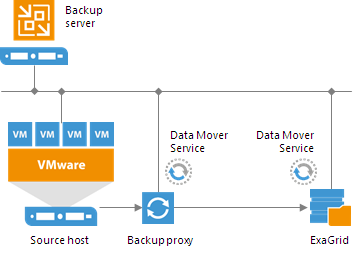 This is an archive version of the document. To get the most up-to-date information, see the current version.
This is an archive version of the document. To get the most up-to-date information, see the current version.ExaGrid
You can use ExaGrid appliances as backup repositories.
ExaGrid uses post-process deduplication. Data deduplication is performed on the target storage system. After VM data is written to disk, ExaGrid analyses bytes in the newly transferred data portions. ExaGrid compares versions of data over time and stores only the differences to disk.
ExaGrid deduplicates data at the storage level. Identical data blocks are detected throughout the whole storage system, which increases the deduplication ratio.
Veeam Backup & Replication works with ExaGrid appliances as with a Linux backup repository. To communicate with ExaGrid, Veeam Backup & Replication uses two Data Mover Services that are responsible for data processing and transfer:
- Data Mover Service on the backup proxy
- Data Mover Service on the ExaGrid appliance

Limitations for ExaGrid
If you use ExaGrid as a backup repository, all tasks in a backup job should be processed sequentially, one by one. This approach helps achieve the best deduplication ratio.
To enable parallel processing for an Exagrid repository, you should configure jobs and backup repositories in the following way:
- Create as many stores on Exagrid as many parallel task you plan to run.
- Configure the same number of backup repositories, each associated with its own store on ExaGrid, and limit the number of concurrent tasks to 1.
- Target every job that you plan to run in parallel at a separate backup repository.
|
Do not create backup repositories directed at the same folder/path on the same device. |
Related Topics